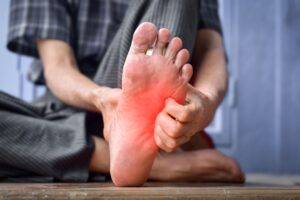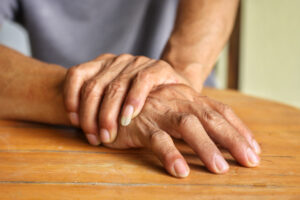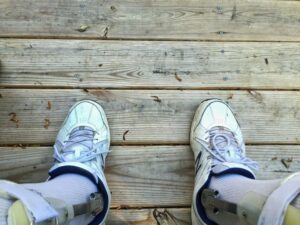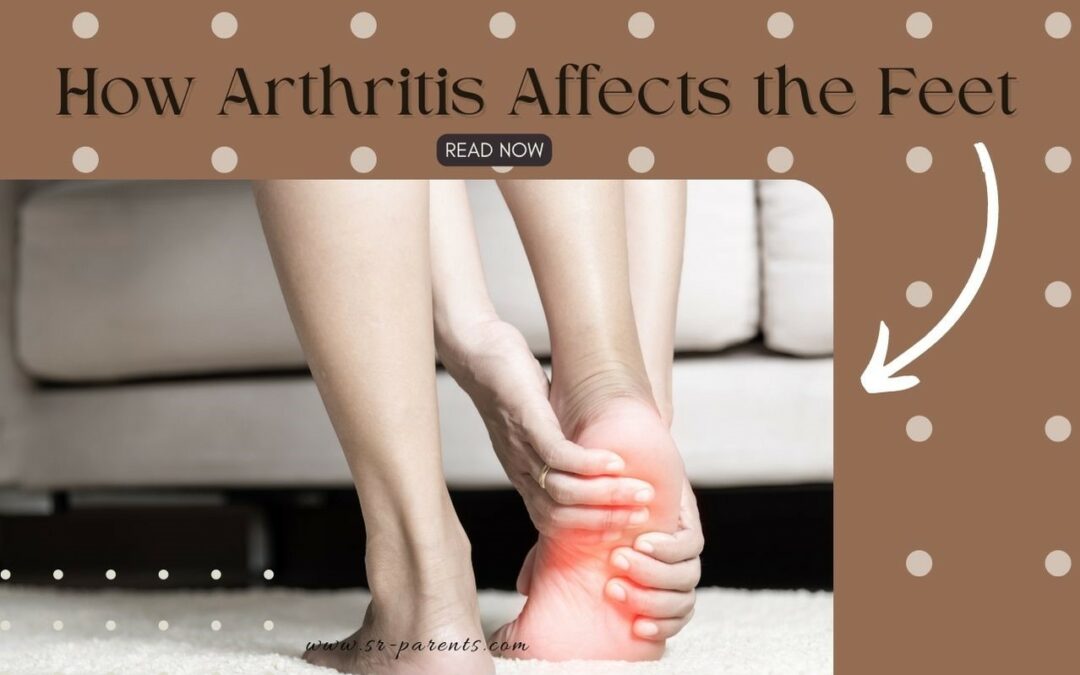Arthritis is one of the common pains older adults face in life. Approximately 1 in 4 U.S. adults (54.4 million people) report a diagnosis of arthritis. Knowing how arthritis affects the feet will help you learn to live with it. Or learn how to help your loved one deal with arthritis. As someone with arthritis, most of the pain I get is in my feet and joints. That was why I needed to learn how to ease the pain. Now I want to share the knowledge I gained and hopefully help others in need.
Contents
How Arthritis Affects the Feet

So, before discussing how arthritis affects the feet, I’d like to define Arthritis first.
What Is Arthritis?
According to the CDC, Arthritis means inflammation or swelling of one or more joints. It describes more than 100 conditions that affect the joints, tissues around the joint, and other connective tissues. Specific symptoms vary depending on the type of arthritis but usually include joint pain and stiffness. There are three common types of arthritis out there. They are osteoarthritis, rheumatoid arthritis, and childhood arthritis.
Osteoarthritis

Alternative Names: Degenerative joint disease or “wear and tear” arthritis.
The most common form of arthritis. According to the NIH, this happens when the cartilage and other tissues within the joint break down or change their structure. This does not happen because of simple wear and tear on the joints. This occurs gradually over time.
What Are the Signs of Osteoarthritis?
According to the NHS, here are the common symptoms of Osteoarthritis that you should look out for:
- joint tenderness
- increased pain and stiffness when you have not moved your joints for a while
- joints appearing slightly more significant or more “knobbly” than usual
- a grating or crackling sound or sensation in your joints
- limited range of movement in your joints
- weakness and muscle wasting (loss of muscle bulk)
You should consult a professional when the symptoms happen more often. A professional will be able to give you medication when necessary.
Rheumatoid Arthritis
Alternative Name: Chronic Polyarthritis
Rheumatoid arthritis (RA) is a chronic autoimmune disease affecting joints. It causes inflammation and damage to the lining of the joints. This results in pain, swelling, stiffness, and reduced joint function. RA affects the small joints of the hand and feet. RA commonly affects the small joints of the hands and feet. But it can also involve other joints, such as the wrists, elbows, knees, and ankles.
What Are the Signs of Rheumatoid Arthritis?
Joint Pain and Swelling
RA usually affects many joints. The joint pain is often symmetrical, affecting both sides of the body. The joints may feel tender, warm, and swollen.
Morning Stiffness
If you have RA, you might feel stiffness when waking up. You may also feel stiffness when you are inactive. This stiffness can last for 30 minutes to several hours.
Fatigue
Many individuals with RA feel a general sense of tiredness and lack of energy. Fatigue can happen due to the chronic inflammation associated with the disease. As well as the physical and emotional strain it imposes.
Joint Deformities
Over time, untreated or poorly controlled RA can lead to joint deformities. The inflammation and damage to the cartilage and bone can cause joints to become misaligned or lose their shape. This can result in deformities like:
- Swan-neck deformity (bent fingers)
- Boutonniere deformity (flexed fingers)
- Ulnar deviation (sideways deviation of the fingers).
Reduced Range of Motion
RA can cause stiffness and limited mobility in the affected joints. It may become difficult to fully bend or straighten the joints, leading to a reduced range of motion.
Systemic Symptoms
In addition to joint-related symptoms, RA can also affect other body parts. Some individuals may experience systemic symptoms such as fever, weight loss, loss of appetite, and generalized muscle aches.
Childhood Arthritis
According to the CDC, arthritis in children is childhood arthritis or juvenile arthritis. The most common type of childhood arthritis is juvenile idiopathic arthritis (JIA), or juvenile rheumatoid arthritis.
What Are the Signs and Symptoms of Childhood Arthritis?
- Joint pain
- Swelling
- Fever
- Stiffness
- Rash
- Fatigue (tiredness)
- Loss of appetite
- Inflammation of the eye
- Difficulty with daily living activities such as walking, dressing, and playing
How Does Arthritis Affect the Feet?
Now that we know the types of arthritis let’s proceed with how they can affect our feet.
Joint Pain and Swelling
Arthritis causes inflammation in the joints, resulting in pain and swelling. In the feet, this can lead to discomfort in the toes, ankles, and other joints. The pain is often worse when you move or stand up for an extended period.
Stiffness and Reduced Range of Motion
Arthritis can cause stiffness in the joints of the feet, making it difficult to move them freely. This stiffness is more pronounced in the morning or after periods of inactivity. It can limit mobility and affect balance and gait. That’s why it’s important also to work out more and maintain a healthier lifestyle.
Deformities and Joint Changes
Over time, arthritis can lead to joint deformities and structural changes in the feet. In Rheumatoid Arthritis, chronic inflammation can damage the joint lining and surrounding tissues, causing joint deformities like bunions, hammertoes, or claw toes. Another critical point is that in Osteoarthritis, the wear and tear on the joint cartilage can result in joint spurs and irregular bone growth.
Difficulty With Weight-Bearing
Arthritis in the feet can make bearing weight on the affected joints challenging. When this happens, a person may favor one side of the body more. Another effect is that we avoid specific movements.
Stability and Balance Issues
This disease can impact balance and stability. Due to pain, stiffness, and joint changes. When this happens, our elderly loved one is more prone to falling and losing balance. That’s why it’s essential to always keep an eye on them.
Limitations on Footwear Choices

When you have arthritis, your choices in footwear are limited. That’s why choosing footwear that will help lessen the pain is essential. If you would like a detailed guide on the best sneakers for arthritic feet, you can just read this article. I made sure to provide clear guidelines to help people with arthritis.
Can You Cure Arthritis?
Sadly, there is no known cure for arthritis. Despite this, while there is no cure, many treatments are available. These treatments manage arthritis symptoms, slow its progression, and improve quality of life.
The treatments include a combination of the following:
Taking Medications
Physical Therapy
Watch YouTube Videos
If you cannot afford to go to a physical therapist, you can watch many Youtube videos. You can spend a little money to be able to exercise.
Video Credit: @arthritisadventure
Surgery
There are rare cases when surgery is the only option. These cases occur when the joints are damaged, and there’s no other option to help. On average, it takes about four weeks for a full recovery. Although you might undergo surgery, it does not guarantee you won’t feel pain anymore.
Last Few Words on How Arthritis Affects the Feet
Additionally, if you want to watch a great video on the signs and symptoms of arthritis, then check this video out.
Video Credit: @OrthoEvalPal
FAQs on How Arthritis Affects the Feet
How does arthritis affect the feet?
Arthritis can affect the feet in several ways. The types of arthritis that affect the feet are rheumatoid arthritis and osteoarthritis.
In Rheumatoid Arthritis. the immune system mistakenly attacks the joints. This can lead to inflammation, pain, and swelling in the feet. In addition, Osteoarthritis occurs due to wear and tear of the cartilage in the joints. Additionally, it causes pain, stiffness, and reduced mobility. Both types of arthritis can affect many joints in the feet. Including the toes, ankles, and the small joints in the midfoot.
What are the symptoms of foot arthritis?
The symptoms of foot arthritis can vary depending on the type and severity of arthritis. We already discussed the common symptoms. But to summarize, they are pain, swelling, stiffness, tenderness, limited range of motion, and difficulty walking.
Another critical point is that there may be visible joint deformities, such as bunions or hammertoes, in some rare cases. The symptoms are often worse after periods of rest or inactivity.
How is foot arthritis diagnosed?
A professional will conduct diagnostic tests. Aside from that. he may look at your family history and diet. Some common tests include X-rays and blood tests. X-rays can reveal joint damage, bone spurs, or narrowing of joint spaces, while blood tests may also detect markers of inflammation and rule out other types of arthritis.
What are the treatment options for foot arthritis?
Here are some of the treatment options available for foot arthritis:
- Medications.
- Physical therapy
- Footwear modifications
- Assistive devices
- Injections
- Surgery
Can a healthy diet help deal with arthritis?
Yes, keeping a healthy weight reduces stress on the joints. That’s why it’s equally important to exercise when able. While it may seem difficult in the beginning, once you form the habit you’ll be unstoppable.
Join a Loving and Compassionate Place for Elderly Care
I can’t wait to interact with you on our other social media platforms!
| SP FB |
| SP Instagram |
| SP Pinterest |
| @senior_parents |





